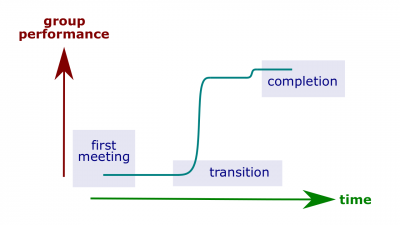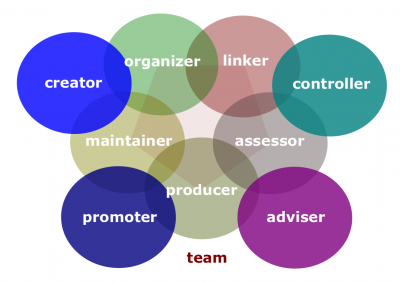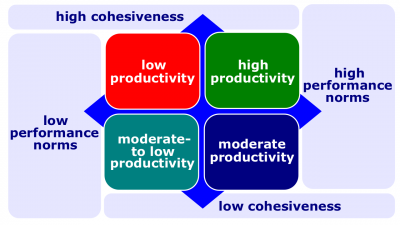Difference between revisions of "OB social concepts"
| (2 intermediate revisions by the same user not shown) | |||
| Line 2: | Line 2: | ||
| − | == | + | ==Groups== |
*[[Group]]. Two or more individuals, interacting and interdependent, who have come together to achieve particular objectives. | *[[Group]]. Two or more individuals, interacting and interdependent, who have come together to achieve particular objectives. | ||
*[[Formal group]]. A designated workgroup defined by an organization's structure. | *[[Formal group]]. A designated workgroup defined by an organization's structure. | ||
| Line 9: | Line 9: | ||
*[[Ingroup favorism]]. Perspective in which we see members of our ingroup as better than other people, and people not in our group as all the same. | *[[Ingroup favorism]]. Perspective in which we see members of our ingroup as better than other people, and people not in our group as all the same. | ||
*[[Outgroup]]. The inverse of an [[ingroup]], which can mean everyone outside the group, but more usually an identified other group. | *[[Outgroup]]. The inverse of an [[ingroup]], which can mean everyone outside the group, but more usually an identified other group. | ||
| − | *[[File:Punctuated-equilibrium.png| | + | *[[File:Punctuated-equilibrium.png|400px|thumb|right|[[Punctuated-equilibrium model]]]][[Punctuated-equilibrium model]]. A set of phases that temporary groups go through that involves transitions between inertia and activity. |
| − | *[[File:Team-roles.png| | + | |
| + | ==Group roles== | ||
| + | *[[File:Team-roles.png|400px|thumb|right|[[Team role]]s]][[Role]]. A set of expected behavior patterns attributed to someone occupying a given position in a social unit. | ||
*[[Role perception]]. An individual's view of how he or she is supposed to act in a given situation. | *[[Role perception]]. An individual's view of how he or she is supposed to act in a given situation. | ||
*[[Role expectations]]. How others believe a person should act in a given situation. | *[[Role expectations]]. How others believe a person should act in a given situation. | ||
| Line 16: | Line 18: | ||
*[[Role conflict]]. A situation in which an individual is confronted by divergent role expectations. | *[[Role conflict]]. A situation in which an individual is confronted by divergent role expectations. | ||
*[[Interrole conflict]]. A situation in which the expectations of an individual's different, separate groups are in opposition. | *[[Interrole conflict]]. A situation in which the expectations of an individual's different, separate groups are in opposition. | ||
| − | *[[Norm]]. An acceptable standard of behavior within a group that is shared by the group's members. | + | |
| + | ==Group norms== | ||
| + | *[[Social norm|Norm]]. An acceptable standard of behavior within a group that is shared by the group's members. | ||
*[[Conformity]]. The adjustment of one's behavior to align with the norms of the group. | *[[Conformity]]. The adjustment of one's behavior to align with the norms of the group. | ||
*[[Reference group]]. An important group to which individuals belong or hope to belong and with whose norms individuals are likely to conform. | *[[Reference group]]. An important group to which individuals belong or hope to belong and with whose norms individuals are likely to conform. | ||
*[[Deviant workplace behavior]] (also known as [[antisocial behavior]] or [[workplace incivility]]). Voluntary behavior that violates significant organizational norms and, in so doing, threatens the well-being of the organization or its members. | *[[Deviant workplace behavior]] (also known as [[antisocial behavior]] or [[workplace incivility]]). Voluntary behavior that violates significant organizational norms and, in so doing, threatens the well-being of the organization or its members. | ||
| + | |||
| + | ==Group-member status== | ||
*[[Status]]. A socially defined position or rank given to groups or group members by others. | *[[Status]]. A socially defined position or rank given to groups or group members by others. | ||
*[[Status characteristics theory]]. A theory that states that differences in status characteristics create status hierarchies within groups. | *[[Status characteristics theory]]. A theory that states that differences in status characteristics create status hierarchies within groups. | ||
*[[Social loafing]]. The tendency for individuals to expend less effort when working collectively than when working individually. | *[[Social loafing]]. The tendency for individuals to expend less effort when working collectively than when working individually. | ||
| − | *[[File:Cohesiveness-and-norms.png| | + | |
| + | ==Group cohesiveness== | ||
| + | *[[File:Cohesiveness-and-norms.png|400px|thumb|right|[[Group cohesiveness|Cohesiveness]] and [[Social norm|norm]]s]][[Cohesiveness]]. The degree to which group members are attracted to each other and are motivated to stay in the group. | ||
*[[Faultiness]]. The perceived divisions that split groups into two or more subgroups based on individual differences such as sex, race, age, work experience, and education. | *[[Faultiness]]. The perceived divisions that split groups into two or more subgroups based on individual differences such as sex, race, age, work experience, and education. | ||
*[[Groupthink]]. A phenomenon in which the norm for consensus overrides the realistic appraisal of alternative courses of action. | *[[Groupthink]]. A phenomenon in which the norm for consensus overrides the realistic appraisal of alternative courses of action. | ||
*[[Groupshift]]. A change between a group's decision and individual decision that a member within the group would make; the shift can be toward either conservatism or greater risk but it generally is toward a more extreme version of the group's original position. | *[[Groupshift]]. A change between a group's decision and individual decision that a member within the group would make; the shift can be toward either conservatism or greater risk but it generally is toward a more extreme version of the group's original position. | ||
| + | |||
| + | ==Group functioning== | ||
*[[Interacting group]]. A typical group in which members interact with each other face to face. | *[[Interacting group]]. A typical group in which members interact with each other face to face. | ||
*[[Brainstorming]]. An idea-generation process that specifically encourages any and all alternatives while withholding any criticism of those alternatives. | *[[Brainstorming]]. An idea-generation process that specifically encourages any and all alternatives while withholding any criticism of those alternatives. | ||
Latest revision as of 14:04, 6 January 2019
OB social concepts are those concepts that are related to groups researched in organizational behavior studies. The concepts below are taken from Organizational Behavior by Robbins and Judge (17th edition); Septem Artes Administrativi served as the primary source of illustrations.
Contents
Groups
- Group. Two or more individuals, interacting and interdependent, who have come together to achieve particular objectives.
- Formal group. A designated workgroup defined by an organization's structure.
- Informal group. A group that is neither formally structured nor organizationally determined; such a group appears in response to the need for social contact.
- Social identity theory. Perspective that considers when and why individuals consider themselves members of groups.
- Ingroup favorism. Perspective in which we see members of our ingroup as better than other people, and people not in our group as all the same.
- Outgroup. The inverse of an ingroup, which can mean everyone outside the group, but more usually an identified other group.
- Punctuated-equilibrium model. A set of phases that temporary groups go through that involves transitions between inertia and activity.
Group roles
- Role. A set of expected behavior patterns attributed to someone occupying a given position in a social unit.
- Role perception. An individual's view of how he or she is supposed to act in a given situation.
- Role expectations. How others believe a person should act in a given situation.
- Psychological contract. An unwritten agreement that sets out what management expects from an employee and vice versa.
- Role conflict. A situation in which an individual is confronted by divergent role expectations.
- Interrole conflict. A situation in which the expectations of an individual's different, separate groups are in opposition.
Group norms
- Norm. An acceptable standard of behavior within a group that is shared by the group's members.
- Conformity. The adjustment of one's behavior to align with the norms of the group.
- Reference group. An important group to which individuals belong or hope to belong and with whose norms individuals are likely to conform.
- Deviant workplace behavior (also known as antisocial behavior or workplace incivility). Voluntary behavior that violates significant organizational norms and, in so doing, threatens the well-being of the organization or its members.
Group-member status
- Status. A socially defined position or rank given to groups or group members by others.
- Status characteristics theory. A theory that states that differences in status characteristics create status hierarchies within groups.
- Social loafing. The tendency for individuals to expend less effort when working collectively than when working individually.
Group cohesiveness
- Cohesiveness. The degree to which group members are attracted to each other and are motivated to stay in the group.
- Faultiness. The perceived divisions that split groups into two or more subgroups based on individual differences such as sex, race, age, work experience, and education.
- Groupthink. A phenomenon in which the norm for consensus overrides the realistic appraisal of alternative courses of action.
- Groupshift. A change between a group's decision and individual decision that a member within the group would make; the shift can be toward either conservatism or greater risk but it generally is toward a more extreme version of the group's original position.
Group functioning
- Interacting group. A typical group in which members interact with each other face to face.
- Brainstorming. An idea-generation process that specifically encourages any and all alternatives while withholding any criticism of those alternatives.
- Nominal group technique. A group decision-making method in which individual members meet face to face to pool their judgments in a systematic but independent fashion.
- Group cohesion. The extend to which members of a group support and validate one another while at work.
- Group functioning. The quantity and quality of a group's work output.
- Workgroup. A group that interacts primarily to share information and to make decisions to help each group member perform within his or her area of responsibility.


